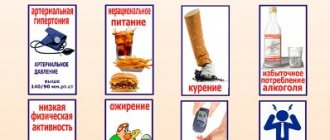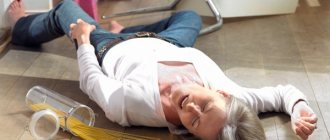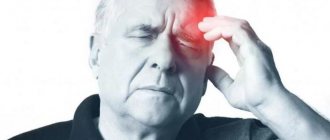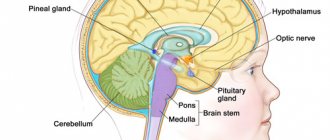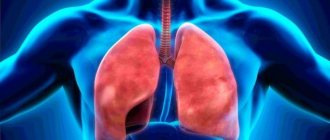21.08.2020
To hypertensive crises (HC)
refers to an increase in blood pressure, which leads to acute disruption of regional (primarily cerebral or coronary) circulation.
Diagnostics.
Increased blood pressure (usually acute and significant) with neurological and/or cardiac symptoms: headache, “floaters” or blurred vision, paresthesia, nausea, vomiting, weakness in the limbs, transient hemiparesis, aphasia, diplopia; cardialgia, palpitations, interruptions in heart function, shortness of breath. GK is often accompanied by dysfunction of the autonomic nervous system.
Diagnostic criteria for GC
:
1. Relatively sudden onset.
- Individually high rise in blood pressure.
The presence of subjective and objective symptoms of a cerebral, cardiac and autonomic nature.
The severity, form and complications of GC should be taken into account.
Uncomplicated hyperkinetic crisis (type 1 hyperkinetic crisis).
Symptoms.
Sudden onset, excitement, mainly an increase in systolic blood pressure with an increase in pulse rate. It develops in the early stages of hypertension and is accompanied by an abundance of “vegetative signs” (muscle tremors, hyperemia and wetness of the skin, tachycardia, and towards the end of the hypertension – polyuria).
-adrenergic receptor blockers – sublingual or metoprolol (egilok) 50 mg
inside;
Calcium antagonists – nifedipine (Corinfar 10 mg
) sublingually;
— dibazol 1% — 6-10 ml
intravenously, has an antispasmodic effect, dilates peripheral vessels, reduces cardiac output;
With severe excitement, anxiety, fear of death:
— seduxen, relanium 5 mg
orally, 1–2 ml (5-10 mg) intramuscularly, intravenously or
droperidol
2 ml of a 0.25% solution (
5 mg
) in 10 ml of physiological solution intravenously.
Uncomplicated hypokinetic crisis (hypokinetic crisis of the second type).
Symptoms.
It occurs in the late stages of the disease against the background of a high initial level of blood pressure, has a gradual development, a severe course, a rise in diastolic blood pressure predominates, and pulse blood pressure decreases slightly. Tachycardia, as a rule, is absent, cerebral and cardiac symptoms are pronounced.
- nifedipine (Corinfar 10 mg
) sublingually;
— capoten 6.25 mg
sublingual;
— clonidine 0.15 mg
sublingually.
3. Complicated crisis with impaired cerebral hemodynamics
(encephalopathy), the main manifestations of which are headache, confusion, nausea, convulsions, blurred vision; acute cerebrovascular accident with the appearance of focal neurological disorders.
— dibazol 1% solution 6-10 ml
intravenous stream;
— aminophylline (aminophylline) 2.4% -10 ml
intravenous drip, has a moderate diuretic effect, improves cerebral circulation;
– magnesium sulfate 25% – 10 ml
intravenously very slowly, preferably as a drip for convulsive syndrome. It has vasodilating sedative, anticonvulsant effects, and reduces cerebral edema.
Hypertensive crisis complicated by the development of angina and/or myocardial infarction:
- nitroglycerin
0.5 mg
sublingually or 10 mg (1% solution 1 ml) intravenously in 100 ml of isotonic sodium chloride solution in the absence of cerebral symptoms at a rate of 8 - 12 drops per minute under blood pressure control or a perfusor;
- β-adrenergic blockers - propranolol (anaprilin) 20-40 mg
sublingually or
metoprolol (Egilok)
in the absence of acute heart failure and other contraindications.
Metoprolol is administered three times intravenously at 5 mg
(bolus) with intervals between injections of 5 minutes.
If the heart rate decreases to less than 60 beats per minute and blood pressure drops below 100 mmHg. Art. After administration of any dose, further administration of metoprolol is stopped. The total dose is 15 mg
.
If hemodynamics remain stable for 6-8 hours, metoprolol is prescribed orally 50 mg
per day with a gradual increase in the dose of the drug.
During hypertensive crisis in patients with exacerbation of coronary artery disease and congestive heart failure
use parenteral administration of ACE inhibitors:
● enalaprilat
intravenously in a stream for 5 minutes at a dose of 0.625 – 1.25 mg;
● quinaprilat –
at a dose of 2.5 – 5 mg intravenously.
Sudden changes in blood pressure can provoke an uncomplicated hypertensive crisis, which occurs against the background of a sharp deterioration in general health and a jump in blood pressure. This condition does not pose a threat to life, since serious pathological changes and damage to blood vessels and the heart do not occur. But the approach to treatment must be competent, since individual manifestations of symptoms may occur.
A little about the nature of the disease
Hypertensive encephalopathy is based on insufficient nutrition of brain cells with oxygen and substances used for energy. Since brain tissue is the most sensitive to hypoxia, its manifestations occur even with a slight restriction of blood flow.
A feature of this pathology is the possibility of reverse development of symptoms only at the initial stage. Once a significant proportion of neurons are destroyed, treatment may not have a significant effect, even if the condition stabilizes. Low blood pressure in such cases further impedes cell function, worsening ischemia.
Signs of encephalopathy are detected with a sustained increase in blood pressure, especially if the course of the disease is accompanied by hypertensive crises. Deterioration in well-being and rapid progression of vascular disorders in the brain are observed in the case of the simultaneous presence of:
- atherosclerotic changes,
- kidney and endocrine diseases,
- intoxication with alcohol or nicotine.
We recommend reading the article on first aid for high blood pressure. From it you will learn about a hypertensive crisis and the dangers of high blood pressure, as well as how to provide assistance.
And here is more information about malignant arterial hypertension.
What is this condition?
An excessive increase in blood pressure can be the first sign of illness or develop in a person against the background of hypertension. There are 2 types of hypertensive crisis: complicated and uncomplicated, which have a characteristic clinical picture. In the uncomplicated type, the pressure limit can range from 130 to 230 mm Hg. Art. Numbers on the tonometer above these indicate that the situation is critical and requires immediate hospitalization. The development of the disease is facilitated by changes in the tone of the walls of blood vessels, a violation of the mechanism of blood pressure regulation, and sharp stimulating signals of the nervous system.
Causes of pathology
Stress, smoking, alcohol, and poor nutrition are accompanying factors in the development of cardiovascular pathologies. Just one unfavorable circumstance can provoke a hypertensive crisis, which will affect the jump in blood pressure:
- psycho-emotional stress;
- chronic fatigue syndrome;
- abuse of alcohol and caffeine;
- hormonal disbalance.
Systematic intake of prescribed medications minimizes the risk of developing this condition.
If a person has hypertension, a crisis can be provoked by irregular therapy of the underlying pathology. A dangerous condition, as a rule, does not occur if you adhere to the prescribed treatment plan. Systematically controlled medication intake has a suppressive effect on the influence of dangerous causative factors.
Drug treatment
For hypertensive encephalopathy, treatment begins with normalizing blood pressure. It is necessary to review the treatment regimen for hypertension, supplement treatment with new medications, or adjust the dosage of medications the patient is taking. To avoid the progression of encephalopathy and other target organ damage, treatment must be supplemented with medications that reduce the risk of developing complications in hypertension.
Specific therapy for encephalopathy is based on taking drugs from the following groups:
- diuretics;
- neuroprotectors;
- means for improving cerebral circulation;
- nootropics;
- ganglion blockers.
Diuretics are prescribed to reduce swelling of the brain tissue. These drugs reduce intracranial pressure, which increases with encephalopathy, reduce the risk of disease progression, and improve overall well-being. For encephalopathy, the doctor prescribes medications with decongestant properties.
Neuroprotectors prevent the death of brain neurons. Taking medications from this group allows you to stop the progression of the disease and protect the brain from the possible consequences of high blood pressure.
Medicines that improve cerebral circulation help reduce the risk of edema and stroke. Nootropics also improve blood circulation in the brain while improving cognitive function. These medications help stop the destruction of personality in dementia and severe forms of encephalopathy.
In case of development of psychoneurological disorders, treatment should be supplemented by a psychiatrist. Patients may be prescribed tranquilizers, antidepressants, or sedatives to reduce mood disorders. Along with drug therapy, the patient is advised to follow a diet and give up bad habits.
The development of encephalopathy can be prevented by timely initiation of adequate drug therapy for hypertension. The medications must be selected by a doctor. If, while taking a particular drug, it is not possible to achieve a sustained reduction in blood pressure below 140 mmHg, the patient should consult with a specialist about expanding drug treatment or replacing the chosen drug with another drug. In addition, the patient must give up bad habits, since smoking and alcohol abuse are triggers for the progression of hypertension.
Clinical picture
An uncomplicated type of hypertensive crisis is accompanied by characteristic signs, in the presence of which the doctor can understand what pathological process is bothering the person. The main and first sign is a headache that is not concentrated in one place.
The pain is strong, it is very difficult to endure and cannot be removed even with the help of pills. After 20-30 minutes of this uncomfortable sensation, signs accompanying the pain begin to appear:
The duration of a hypertensive crisis is about 3 hours. High blood pressure levels continue to persist for a long period of time, so the patient often experiences a panic attack because of this situation. Against the background of characteristic symptoms, chest pain may appear.
Causes of the disease
Since hypertensive encephalopathy is a consequence of an increase in blood pressure to dangerous levels, therefore, the main cause of the development of the disease is arterial hypertension. There are a number of factors that significantly increase the risk of developing brain damage. These include:
- severe kidney pathologies;
- suffered a cerebral stroke;
- high cholesterol;
- complicated hypertensive crisis.
In hypertension, the risk of developing encephalopathy depends on therapy and blood pressure levels and the presence of aggravating factors. These include bad habits, excess weight, physical inactivity, and any chronic diseases.
In severe kidney pathologies, a change in blood viscosity occurs. In this case, blood circulation in the brain is disrupted, and due to hypertension, vascular tone changes. All this triggers a pathological process in the nervous tissue of the brain due to a lack of nutrients and oxygen supplied with the blood.
Having suffered a stroke increases the risk of developing encephalopathy in hypertensive patients by 3 times. This is due to focal changes in the brain after a stroke.
High levels of cholesterol and glucose in the blood provoke a narrowing of the lumen of blood vessels, including in the brain. This complicates the transport of oxygen, disrupts metabolic processes occurring in the brain tissue, and increases the risk of developing encephalopathy. A sudden increase in pressure aggravates the pathological process and becomes an impetus for the development of the disease.
Diagnostic methods
After interviewing the patient, the doctor will be able to guess what is wrong with him.
There is no need to take special measures to establish the disease. The doctor needs to describe all the symptoms and answer questions about the medical history. Information about normal blood pressure levels for humans, the duration of an attack, accompanying pathological processes, and chronic diseases is important. It is important for the doctor to understand whether such attacks have occurred before and what medications were taken.
The presence of pathological symptoms from the cardiovascular system is a signal for an ECG study. It is necessary to exclude the development of acute coronary syndrome (heart attack). When the patient's condition improves, the specialist may order an MRI to obtain information about the presence or absence of damage to the circulatory system.
Urgent Care
1. Lay the patient down with the head end elevated and ensure patency of the upper respiratory tract.
2. Oxygen therapy.
3. As first aid, you can prescribe sublingually or orally:
- nifedipine (in 1 tablet - 10 and 20 mg) at a dose of 0.25-0.5 mg/kg or
captopril (in 1 tablet - 12.5, 25 and 50 mg) at a dose of 0.1-0.2 mg/kg or
clonidine (in 1 tablet - 0.075 and 0.150 mg) at a dose of 0.002 mg/kg; parenterally:
0.01% solution of clonidine in a dose of 0.3-0.5-1.0 ml (depending on age) IM or IV in 0.9% sodium chloride solution slowly over 5-7 minutes.
As an adjuvant, a 1% dibazole solution can be used at a dose of 0.1-0.2 ml/year of life IM or IV.
4. In case of agitation and severe neurovegetative symptoms, administer a 0.5% solution of seduxen at a dose of 0.1 ml/kg (0.5 mg/kg) intramuscularly.
5. For symptoms of intracranial hypertension (headache, vomiting, disorientation, etc.), administer a 1% Lasix solution at a dose of 0.1-0.2 ml/kg (1-2 mg/kg) IM or IV.
6. If there is no effect from treatment, prescribe:
- sodium nitroprusside (nanipruss) at a dose of 0.5-1 mcg/kg per minute IV titrated under blood pressure control (during the infusion, the head of the patient's bed should be elevated, and the patient should avoid sudden changes in body position) or
hydralazine 0.1-0.5 mg/kg IV or
diazoxide 1 mg/kg i.v.
7. For crises caused by pheochromocytoma, administer:
- phentolamine at a dose of 2-5 mg IV with repeated administration of the drug every 5 minutes until blood pressure decreases or
tropafen at a dose of 10-30 mg IM or 5-15 mg IV or
phenoxybenzamine chloride at a dose of 10 mg/day i.v.
If there is an excessive decrease in blood pressure, intravenous administration of an isotonic sodium chloride solution is indicated, and if this measure is ineffective, the use of mezatone is indicated.
Admission to the intensive care unit or intensive care unit after emergency care. Once the patient's condition has stabilized, the patient should be prescribed a long-acting antihypertensive drug.
Hypertensive crisis
- a sudden increase in blood pressure, causing a significant deterioration in health and requiring emergency care.
In children and adolescents, hypertensive crises predominantly occur with secondary (symptomatic) arterial hypertension.
Causes of secondary arterial hypertension
- Diseases of the kidneys and renal vessels
(acute and chronic glomerulonephritis, pyelonephritis, stenosis and thrombosis of the renal arteries, renal hypoplasia, reflux nephropathy, hydronephrosis, Wilms tumor, condition after kidney transplantation, etc.).
Diseases of the heart and blood vessels
(coarctation of the aorta, aortoarteritis, aortic valve insufficiency).
Endocrine diseases
(pheochromocytoma, hyperaldosteronism, hyperthyroidism, hyperparathyroidism, Cushing's syndrome, diencephalic syndrome).
Central nervous system diseases
(brain injury, intracranial hypertension).
Taking medications
(sympathomimetics, glucocorticosteroids, anabolic steroids, drugs (codeine, etc.)).
However, in older children and adolescents, a hypertensive crisis can also occur with primary arterial hypertension.
Classification of hypertensive crises
- Type I
- hyperkinetic (sympathoadrenal, neurovegetative).
Type II
- hypokinetic (norepinephrine, water-salt).
Symptoms of hypertensive crisis
The clinical picture depends on the type of hypertensive crisis.
Hypertensive crisis type I.
Characterized by a sudden increase in systolic (mainly), diastolic and pulse blood pressure. At the same time, complaints of a neurovegetative and cardiac nature predominate in children. They experience severe headache, dizziness, nausea, sometimes vomiting, and weakness. Children are excited and feel a sense of fear. Typical complaints are palpitations and pain in the heart area. Red spots on the face and torso, coldness of the extremities, chills, trembling, sweating, blurred vision and hearing often occur. After a crisis, as a rule, a large amount of urine with low specific gravity is released. During laboratory examination, leukocytosis is determined in the blood, the glucose content in the blood serum is increased, signs of hypercoagulation are detected, proteinuria and hyaline casts are detected in the urine. The duration of the attack is usually no more than 2-3 hours.
Hypertensive crisis type II
develops more slowly. In patients, systolic and especially diastolic blood pressure increases significantly, while pulse pressure does not change or decreases. The clinical picture is dominated by changes in the central nervous system; the level of norepinephrine in the blood is increased with normal glucose levels. The duration can range from several hours to several days.
During hypertensive crises, complications that threaten the child's life may occur: hypertensive encephalopathy, cerebral edema, hemorrhagic or ischemic stroke, subarachnoid hemorrhage, pulmonary edema, acute renal failure, retinopathy, retinal hemorrhage.
Emergency care for hypertensive crisis
Strict bed rest is indicated for children with hypertensive crisis; frequent (every 10-15 minutes) determination of blood pressure, constant assessment of health status; if necessary, record an electrocardiogram. Treatment of a hypertensive crisis depends on the presence of complications.
Uncomplicated hypertensive crisis
- Hypertensive crisis type I.
Its treatment, especially in the presence of tachycardia, is advisable to begin with the administration of beta-blockers (atenolol is administered at a rate of 0.7-1.5 mg/kg/day, metoprolol - 3-5 mg/kg/day). Treatment can also be started with nifedipine, which is prescribed sublingually or orally at a dose of 0.25-0.5 mg/kg. If the effect is insufficient, you can use clonidine at a dose of 0.002 mg/kg sublingually or orally, captopril sublingually, 0.25% solution of droperidol (0.1 mg/kg) intravenously.
Hypertensive crisis type II.
First of all, nifedipine should be prescribed sublingually (0.25-0.5 mg/kg). Simultaneously with nifedipine, a fast-acting diuretic furosemide is prescribed at a rate of 1-2 mg/kg intravenously. Following this, it is recommended to prescribe ACE inhibitors. In cases of agitation and high activity of the sympathoadrenal system, the use of droperidol and diazepam (0.25-0.5 mg/kg) is justified.
Complicated hypertensive crisis
- Hypertensive encephalopathy, acute cerebrovascular accident, convulsive syndrome.
In addition to nifedipine and furosemide, a 0.01% solution of clonidine intramuscularly or intravenously, magnesium sulfate, and diazepam are prescribed. In addition, you can intravenously inject sodium nitroprusside at a dose of 0.5-10 mg/kg/min) with a gradual increase or use ganglion blockers.
Acute left ventricular failure.
In case of hypertensive crisis with manifestations of acute left ventricular failure, emergency care is recommended to begin with intravenous administration of nitroglycerin, sodium nitroprusside (2-5 mcg/kgmin)] or hydralazine (0.2-0.5 mg/kg). In addition, it is necessary (especially for pulmonary edema) to prescribe furosemide. If the effect is insufficient, clonidine, droperidol, and diazepam are used.
Pheochromocytoma.
Catecholamine crises are stopped with the help of α-blockers. Phentolamine is diluted in 0.9% sodium chloride solution and administered intravenously very slowly at 0.5-1 mg every 5 minutes until blood pressure normalizes). Tropodifene is administered intravenously very slowly, 1-2 mg every 5 minutes until blood pressure decreases).
And its complications, caused by a sharp increase in blood pressure, are very dangerous.
The longer the elevated blood pressure level persists, the more serious the complications of a hypertensive crisis.
What are the consequences, what is the danger of this condition, and what emergency assistance can be provided, we will consider in this article.
Hypertensive crisis is a special condition that is typical for people prone to high blood pressure and who have not received the necessary treatment or who have received poor-quality treatment. Often, sudden changes in weather conditions can become...
Doctors identify the following causes of a hypertensive attack:
- disorders of the cardiovascular system;
- untimely use of antihypertensive drugs;
- various head injuries;
- addiction to alcohol or drugs;
- presence of tumors;
- glomerulonephritis in the acute stage.
To avoid serious consequences due to pressure surges, you need to listen to your body and take preventive measures.
Treatment
The patient is subject to mandatory hospitalization in the intensive care unit and observation by a whole team of doctors: resuscitator, neurologist, neurosurgeon, ophthalmologist, etc.
Diagnosed OGE requires the use of long-acting drugs.
It is mandatory to prescribe diuretics that relieve swelling of brain tissue - Furosemide, ethacrynic acid, Lasix, etc. Control of blood electrolytes is also important to prevent total cerebral ischemia.
You cannot quickly reduce the existing pressure; the process must be gradual. During the first hour, the decrease should not exceed 20% for systolic and 15% for diastolic, and in the next 24 hours the pressure should become optimal for the subject. Diastolic pressure should not fall below 90 mmHg.
With a strong sharp imbalance of cerebral blood flow, the decrease in systolic pressure should be even slower: the upper one is no more than 15%, the lower one – 10% of the normal level.
To accelerate the initial decrease in blood pressure, the drug sodium nitroprusside (0.3-0.5 mcg/kg per 1 minute) is administered intravenously - it allows you to control the decrease in blood pressure.
Main action drugs (Clonidine and Clonidine) are also used intravenously in the form of a dropper in saline or as a bolus of 1-2 ml.
The antihypertensive drug Hypostat gives good results; it normalizes blood pressure within a few minutes.
Next, it is possible to switch to tablets - adrenergic blockers, calcium ion antagonists (Nifedipine - improve cerebral blood flow), ACE inhibitors (Enalapril, Captopril - optimize vascular tone), diuretics and other drugs.
To prevent new edema and reduce existing edema, Prednisolone and Dexamethasone are prescribed.
In the treatment of acute hypertensive encephalopathy in the presence of convulsive syndrome, Relanium is prescribed.
“Magnesia” and “Eufillin” will also have a calming and sedative effect. Due to disruption of lipid oxidation processes, antioxidants are prescribed:
- droppers with Mexidol 400 mg;
- "Ceraxon" 1000 mg;
- "Cytoflavin" 10 ml intravenously.
It is very good to combine them with gluconeogenesis activators: mildronate 10-20 ml intravenously as a dropper.
Preventive drugs are Cavinton and Vinpocetine for 3 months. Hirudotherapy has a good effect.
Characteristic symptoms
The development of a crisis is characterized by a number of symptoms that should be known; however, there are cases when this condition occurs in a patient without severe symptoms:
- headache;
- blurred vision;
- sharp pain in the chest area;
- strong excitement, fear;
- nausea;
- dyspnea;
- loss of consciousness.
These are the main symptoms indicating the presence and complication of a hypertensive attack. Arrhythmia or paresthesia may also be observed, but these are quite rare signs.
At the first manifestations of symptoms, you need to contact a specialist; this will help to diagnose the disease in time and prevent its development and complications.
Hypertensive crisis, complicated and uncomplicated
Based on general symptoms, as well as whether target organs are affected, two types of crisis are distinguished: complicated and uncomplicated.
A complicated hypertensive crisis initially affects target organs and is a real threat to the patient.
To stabilize the condition, it is necessary to reduce blood pressure immediately, within a maximum of one hour.
A complicated crisis is characterized by the manifestation of serious symptoms with their further intensification. They pose a threat to the patient’s life and therefore must be eliminated as soon as possible. First aid is provided by administering intravenously the necessary drugs aimed at reducing blood pressure.
An uncomplicated attack does not affect target organs and is potentially life-threatening. It is necessary to reduce blood pressure quickly enough - no more than in a few hours.
Pain in the heart area is one of the harbingers of a hypertensive attack
Despite the fact that the condition is often not accompanied by acute symptoms, an uncomplicated hypertensive crisis, the complications of which are extremely dangerous, becomes a threat to the patient’s life, since there is always a risk of late detection of this condition.
As a result, the problem can become more serious or lead to death. The main signs of a crisis are a pronounced headache, pain in the heart with rhythm disturbances, and sometimes trembling or fear.
You should know the signs of a complicated and uncomplicated attack so that, if necessary, you can determine what measures to take to provide first aid.
Causes and risk factors
Among the main reasons due to which an uncomplicated hypertensive crisis occurs, the following are usually distinguished:
- Heredity;
- Some chronic diseases (cardiovascular pathologies, thyroid gland, kidneys);
- Age. In men, high blood pressure often appears after 50 years of age, in women after 60 years of age;
- Severe intoxication;
- Wrong lifestyle. More often this is the abuse of junk food, sedentary work, smoking and drinking alcohol.
Sometimes the cause of a crisis is a sudden change in climate or increased physical stress on an unprepared body.
It is also not recommended to suddenly stop taking medications for hypertension. Such withdrawal of medications can also lead to an increase in blood pressure.
Emergency care for uncomplicated hypertensive crisis
To determine an uncomplicated attack, it is necessary to monitor the severe symptoms.
Thus, the patient’s condition sharply worsens and is accompanied by increased excitability and lack of air, trembling, headache and increased sweating.
Blood pressure also increases significantly. If first aid is provided promptly and efficiently, then the patient’s life is not in danger.
If the state of crisis takes you by surprise, then you should always know how to eliminate this problem so that there are no serious consequences. People who often suffer from a similar condition must remember how emergency care is provided for an uncomplicated attack. Now this condition can be eliminated by stabilizing blood pressure levels.
Blood pressure lowering drug Captopril
The following tips should be followed:
- It is not recommended to reduce blood pressure very quickly; a reduction of no more than 20-25% is permissible;
- within 6 hours from the onset of the crisis, a decrease to 160/100 mm is permissible. rt. Art.;
- You can reach normal blood pressure within 24 hours.
Emergency measures:
- The patient must be laid horizontally in a ventilated area and not disturbed. Take 2 pieces under the tongue. After 25-30 minutes, measure the pressure. If a decrease is not observed, then take more according to the instructions. If the patient exhibits increased excitability, then 25-40 drops of Valerian should be taken;
- Having provided the patient with first emergency aid, it is necessary to immediately go to the hospital and not self-medicate, since unprofessional treatment can lead to deterioration of health, complications and death.
General symptoms of encephalopathy
Hypertensive encephalopathy, also called dyscirculatory encephalopathy, does not develop immediately. Brain damage slowly increases as blood circulation changes due to increased pressure. This process can be stopped by timely complex therapy of hypertension.
There are three degrees of encephalopathy. Each form of brain damage has its own symptoms and course.
The following symptoms are characteristic of grade 1 hypertensive encephalopathy:
- deterioration of attention;
- fast fatiguability;
- headache;
- dizziness;
- occasional nausea.
Symptoms are short-term and intensify with increased blood pressure. Hypertensive encephalopathy of the second degree manifests itself with the same symptoms, but the disorder is permanent. Progression of the disease to the next stage of dyscirculatory encephalopathy or DEP of the 2nd degree is accompanied by symptoms of a neurological nature - impaired coordination of movements, confusion, hearing impairment. Neuropsychiatric changes also appear, manifested by depression, irritability, and periodic panic attacks.
In hypertension, grade 3 dyscirculatory encephalopathy is the most unfavorable prognosis. This form of brain disorder is characterized by the following symptoms:
- sudden deterioration of vision;
- hearing loss;
- constant dizziness;
- disorientation in space;
- balance problems;
- change in gait;
- paresis and paralysis;
- sudden panic attacks.
Read also: Alternative treatment for stage 2 hypertension
Specific symptoms are associated with hypertension, so the earlier treatment for hypertension and cerebrovascular disorders is started, the better the prognosis, since the changes that occur with hypertensive encephalopathy are reversible.
Constant dizziness, disorientation in space - symptoms that seriously complicate life
Acute hypertensive encephalopathy
The most dangerous disorder with high blood pressure is acute hypertensive encephalopathy. It develops at the moment of increasing pressure during a hypertensive crisis. In this case, the compensatory function of the body weakens, so the brain damage is severe. Acute hypertensive encephalopathy develops rapidly with a sudden surge in pressure above 180 mmHg. Symptoms characteristic of this condition:
- rapidly increasing headache;
- severe vomiting;
- sudden deterioration of vision;
- dizziness;
- short-term convulsive attacks;
- confusion;
- short-term paresis.
This condition is very dangerous and requires urgent hospitalization.
Headache in acute encephalopathy increases sharply, begins from the back of the head and spreads to the entire head. It is oppressive in nature and may cause an aura characteristic of migraine. During vomiting, the pain intensifies, but there is no relief.
During an attack, intracranial pressure rises sharply. This leads to swelling of the optic nerve, which causes sudden deterioration of vision.
Acute encephalopathy, provoked by a complicated crisis, is dangerous due to the development of cerebral edema. This condition requires immediate hospitalization, otherwise it can be fatal. Lack of timely treatment leads to the appearance of foci of ischemia in the brain tissue. This is accompanied by disruption of neural activity and their massive death. The most common complication of acute encephalopathy against the background of a hypertensive crisis is a cerebral stroke.
Brain edema is a dangerous condition
Chronic form of pathology
The chronic form of the disease is characterized by slow progression. Encephalopathy passes from one stage to another due to the lack of adequate treatment for hypertension.
In grade 1 hypertension there are no signs of cerebrovascular disorders. With grade 2 hypertension, the initial form of hypertensive encephalopathy may develop. It is characterized by smoothed symptoms, the main complaint of patients is headache. Dizziness and nausea are rare.
With grade 2 hypertension, encephalopathy can progress for the following reasons:
- presence of aggravating risk factors;
- lack of adequate treatment for hypertension;
- associated neurological disorders.
Over time, encephalopathy progresses to second-degree cerebrovascular damage. This pathology is characterized by the addition of neurological symptoms that complicate the patient’s life.
Headache and nausea with grade 2 encephalopathy become persistent and can persist for several days. Moreover, the higher the pressure, the more pronounced the symptoms of brain dysfunction.
Encephalopathy grade 3, in addition to the specific symptoms that are observed in the early stages of the disease, is characterized by a change in the patient’s personality. Due to damage to brain neurons, cerebral encephalopathy can lead to impaired social adaptation, loss of ability to work, and disability, which is why hypertension is dangerous.
Major complications
The consequences of a crisis can be very serious, the most common of which are:
- impaired blood circulation in the brain;
- heart rhythm disturbances, arrhythmia;
- heart attack;
- pulmonary edema;
- cardiac asthma.
Complications that manifest themselves in the cardiovascular system lead to changes in the functioning of the heart. This manifests itself as angina pectoris and coronary heart disease.
With angina pectoris, the heart begins to beat faster due to impaired blood circulation to the muscle, as a result of which the patient may feel a burning sensation and pain. If the supply to the myocardial muscle is disrupted, the consequence is ischemic disease. Initially, a change in rhythm is observed - tachycardia and angina, and subsequently - a heart attack.
Hypertensive crisis complicated by pulmonary edema is a fairly common occurrence. When the left ventricle of the heart does not work at full strength, blood stagnation forms in the pulmonary circulation, which is the main reason why pulmonary edema occurs during a hypertensive crisis.
The main signs by which pulmonary edema can be recognized:
- constant lack of air;
- cough accompanied by loud wheezing;
- pale skin;
- change in heart rate;
- dyspnea.
Such serious complications can be avoided if the disease is diagnosed in a timely manner, consult a specialist for treatment, and also follow preventive measures, which we will discuss later.
How to treat the disease?
Encephalopathy during a hypertensive crisis occurs suddenly. Therefore, treatment must be timely and intensive. When concomitant pathologies are excluded or managed, patients are prescribed a drug regimen consisting of the use of antihypertensive drugs and neuroprotectors. Angiotensin-converting enzyme inhibitors, beta-blockers and calcium channel antagonists are prescribed. Diuretics are recommended to reduce swelling. For the purpose of neuroprotection, nootropics (Piracetam) are used. To correct microcirculation, it is recommended to take the drug “Cytochrome-C”.
Preventive actions
Crisis is a more severe form of hypertension, which is quite common nowadays. Nervous tension, sedentary work, poor lifestyle, all this can affect your health and the development of diseases.
By following some simple rules, you can significantly reduce the risk of a crisis or reduce its complications:
- the right way of life. You need to try to follow the regime, lead an active lifestyle, avoid drinking alcohol and nicotine-containing substances;
- if you have hypertension, strictly follow the doctor’s instructions and do not neglect his advice;
- be examined by a cardiologist once every six months;
- regular measurement of blood pressure for control purposes.
Follow these tips and the risk of an attack, as well as complications, will be significantly reduced.
Video on the topic
The most common consequences of a hypertensive attack:
If there is a sharp change in pressure and the symptoms described above, then it is necessary to immediately provide first emergency aid and call an ambulance for further examination and provision of the necessary medical care by specialists. Do not delay treatment, because the sooner the attack is stopped, the fewer consequences and complications it will entail. Take care of yourself and be healthy!
It is not the rise in pressure itself at the time of a hypertensive crisis that is dangerous, but the consequences of this condition. In a complicated crisis, the risk of neurological complications and heart failure is high.
It is regarded as the body's inability to regulate blood pressure. A sharp jump in blood pressure, which is accompanied by other dangerous symptoms, can cause complications of a hypertensive crisis.
A crisis occurs in 1% of people with hypertension, of which about 3% of people experience a complication. Pressure readings are not an absolute sign to confirm the diagnosis. For example, in hypotensive people, an increase in blood pressure to 130/90 can cause collapse, while people whose usual blood pressure is 140/90 can feel normal at 160/110.
Hypertensive crises are classified into complicated and uncomplicated. The crisis can last from several hours to days. The condition is aggravated by the patient's feeling of fear, anxiety, blurred vision, and vomiting. Complications of blood circulation, both cerebral and coronary, pose a particular danger to human life.
If during a hypertensive crisis the pressure suddenly rises to critical levels (over 220/120), neurovegetative disorders and changes in the central nervous system, heart, and blood vessels are observed in parallel. The longer the pressure remains high, the more severe and irreversible the complications.
Manifestations and symptoms of hypertensive encephalopathy
Although hypertension is a risk factor, encephalopathy does not develop very often in such people. The fact is that a chronic increase in blood pressure in many cases leads to adaptation of the brain vessels.
Much more dangerous are sudden fluctuations in pressure. Therefore, most often this complication, especially acute hypertensive encephalopathy, develops in fairly young patients.
These could be pregnant women with eclampsia, children with glomerulonephritis, men 40-45 years old who abuse alcohol and drugs. It is possible to develop hypertensive encephalopathy in hospital patients receiving medications that increase the amount of stimulating hormones in the blood, especially in overdose.
Symptoms of encephalopathy appear gradually, they can increase within two days. This is what helps to distinguish encephalopathy from a stroke, because the symptoms are similar, but a stroke develops very quickly, even suddenly.
First manifestations
- Nausea;
- Vomit;
- Vision problems.
If color blindness suddenly appears, vision sharpness decreases, or unilateral vision loss appears, you should immediately consult a doctor, as these symptoms may indicate encephalopathy.
If treatment is started immediately, then no further development of symptoms occurs and the brain is completely restored. If timely assistance is not provided, the problem worsens, neurological symptoms appear, and convulsions, coma and death are possible in the future.
Neurological symptoms
- Disorientation in space;
- Confusion;
- Loss of balance;
- Hearing problems;
- Paresis;
- Paralysis.
Symptoms may be accompanied by feelings of fear or increased anxiety. Despite the severe symptoms of encephalopathy, a distinctive feature of this disorder is the complete reversibility of changes in most cases.
Full recovery is possible if it is possible to lower blood pressure to the point where severe cerebral edema develops and the cerebellum becomes wedged into the foramen magnum of the skull.
The diagnosis is made based on the nature of the symptoms, medical history, examination of the patient and examinations that differentiate encephalopathy from other diseases with similar symptoms. It is necessary to exclude stroke, brain tumors and some other diseases. To clarify the diagnosis, encephalography, MRI, and computed tomography are performed.
A person with signs of acute hypertensive encephalopathy should be hospitalized as quickly as possible. It is important to do this on time, because his life is at risk. Intensive therapy is required.
The general recommendation for urgent measures is to lower the pressure to normal levels. However, its rapid reduction is recommended only for patients who do not suffer from chronic hypertension.
If your blood pressure is chronically high, especially if you are an elderly person, then you need to reduce your blood pressure gradually, by about 25% in the first hour of therapy. More drastic measures may worsen the condition and aggravate the manifestation of neurological symptoms.
Sodium nitroprusside is most often used to treat hypertensive encephalopathy. This drug has an almost instant effect, and is quickly eliminated from the body. However, its use is possible only with constant monitoring of the patient’s blood pressure. If the pressure cannot be lowered, complications may develop that can be fatal.
Neurological complications
Disorders of this kind more often occur in patients with hypertension due to unsystematic or inadequate treatment. Stress and anxiety can have an impact. Weather-dependent people experience sudden surges in pressure when the weather changes. Patients show signs of complications to varying degrees.
Neurological disorders occur quite often. A hypertensive crisis complicated by encephalopathy is especially dangerous.
The first signs of neurological disorders appear approximately 12 hours after the increase in pressure. Main symptoms: headache, anxiety. Further, confusion, memory loss, and drowsiness occur. The patient may be overly irritable or depressed, sometimes euphoria occurs, nausea occurs, vomiting is possible, and convulsions occur. If help is not provided in time, the patient falls into a coma.
Focal disorders of certain areas of the central and peripheral nervous system often occur, which affects one or another part of the patient’s body. There is a loss of control over movements, their deficit, a decrease or increase in muscle tone, tremor, and paralysis. Hearing and vision disorders are typical, and speech may be absent. It all depends on the location of the lesion in the brain or spinal cord. If brain disorders cover a large area, the entire nervous system is affected.
Heart failure
Significant, long-term elevated blood pressure can cause the development of angina. Manifestations of coronary heart disease are another common complication of a hypertensive crisis.
Long-term increased pressure affects the functioning of the heart, overload leads to tension in the walls of the left ventricle, and the organ’s need for oxygen increases. This is how the discrepancy between the need of the heart and the ability of the vessels to deliver the required amount of oxygen grows. In this case, along with antihypertensive drugs, diuretic therapy will be required.
During an angina attack, a person feels a dull pain in the area behind the sternum. At the same time, the person experiences a feeling of fear, weakness, and cold, sticky sweat appears. Sometimes an attack is characterized by a burning sensation in the central part of the chest and neck. symptoms occur even in a calm state due to spasm of a section of the coronary artery.
With coronary artery disease, due to insufficient oxygen supply to the heart muscle, the walls of the heart become thinner, the muscle ceases to perform its functions, heart rhythm disturbances appear, and tachycardia develops. The lack of normal blood supply leads to tissue atrophy and myocardial infarction occurs. Any heart failure is expressed by difficulty breathing, severe shortness of breath, and anxiety of the patient for his life.
Causes of pathology
A complicated hypertensive crisis does not appear by chance. The appearance of a complicated form of the disease is influenced by many factors, including external and internal. External factors include abuse of salty foods, stress, excessive alcohol consumption, consumption of fatty, spicy, smoked foods.
Internal reasons for the development of pathology:
- impaired renal function, including nephroptosis;
- atherosclerotic vascular lesions;
- excessive mental or physical stress;
- weather dependence;
- complications from lupus;
- complications of diabetes;
- heart failure;
- diseases of the heart and blood vessels;
- neuropsychiatric disorders;
- pathologies of the nervous system.
Complications of a hypertensive crisis may occur due to uncontrolled use of antihypertensive drugs or premature cessation of medications prescribed by a doctor.
In case of a hypertensive crisis, an ambulance is called for the patient
Respiratory system disorders
One of the consequences of hypertensive crises is pathology of the pulmonary apparatus. Complications of this kind are associated with stagnation of blood in the pulmonary circulation. Due to poor blood supply to the heart muscles, the functioning of the ventricle is disrupted, and pulmonary edema forms. A person suffers from lack of air and experiences suffocation. The patient experiences shortness of breath even at rest.
With the development of complications of a crisis from the respiratory system, a cough appears, accompanied by wheezing. After a coughing attack, frothy pink sputum is released. Moist rales are heard in the lungs. The skin is pale with a bluish tint, cyanosis of the nasolabial triangle occurs. The heartbeat becomes frequent, cold sticky sweat appears, the liver enlarges, the lower limbs swell, and then the torso. Ascites often develops - the accumulation of fluid in the abdominal cavity.
Vascular complications
High pressure can cause the vessel wall to rupture. When a cerebral hemorrhage occurs, the patient suffers a stroke. The release of blood into the heart muscle is fraught with a heart attack. An aneurysm rupture (bulging of the vessel wall) is extremely dangerous. Under the influence of high internal pressure, the vessel ruptures at its thinnest point.
Damage to the aorta or dissecting aneurysm causes severe bleeding that is incompatible with life.
The pathology is characterized by severe pain with the development of shock. Depending on the location of the damage, aortic insufficiency, fluid accumulation in the pericardium, and circulatory disturbances in the brain, small intestine, or extremities occur.
To prevent the occurrence of such complications, blood pressure must be reduced during the first hours after the onset of signs of a crisis. Treatment of complicated hypertensive crisis occurs in a hospital setting. As an emergency measure, the patient receives medications through intravenous infusions, taking into account fluctuations in blood pressure and cardiac activity. This method ensures rapid delivery of a certain dose of medication and control of the speed of its administration.
If there is a danger of a sharp drop in pressure, the administration of the drug can be suspended to prevent hypotension. The pressure reduction should be smooth and gradual. For headaches, diuretics are recommended. Such drugs will be effective if the pain is caused by increased arterial and intracranial pressure. Pain in the heart can be relieved by nitroglycerin or.
Causes
The reasons that provoke the development of an attack are usually attributed to a number of external factors. These include excessive salt abuse and bad habits, non-compliance with work and rest schedules, weather conditions and their sudden changes, and psycho-emotional factors. Often a crisis occurs due to the withdrawal of certain medications. In particular, clonidine and beta-blockers can cause this.
Factors in the emergence of a crisis include internal diseases of a cardiac nature, as well as a number of other pathologies:
Sometimes surgical interventions performed on the heart lead to this pathology.
A complicated hypertensive crisis develops gradually, its symptoms last for several days, starting as a mild malaise. Initially, weakness, tinnitus, vomiting and nausea appear, then a severe headache joins these symptoms. Sometimes a person is inhibited, has poor reactions, and hearing and vision deteriorate.
Shortness of breath is one of the common symptoms of a crisis. Wheezing is heard, the patient does not have enough air, he experiences suffocation. This symptom becomes weaker when taking a semi-sitting position, and only worsens when lying down. From the outside, it is noticeable that the person is unusually pale, the surface of the skin is cool and dry, and the face turns red. Typically, the pulse remains at the normal level, the patient’s limbs tremble. Women may notice general swelling.
The disease is distinguished by the fact that symptoms persist for some time after the end of the attack. The manifestations of a crisis depend a lot on its type and form, so the signs described above can be supplemented by various symptoms from the cerebral, cardiac and other body systems. The main symptom, of course, remains high blood pressure.
The following video will also tell you in detail about the symptoms of a hypertensive crisis:
Uncomplicated hypertensive crisis
This type does not lead to damage to target organs, and there is no need for hospitalization of the patient. Uncomplicated by short-acting drugs. These are tablet forms for oral or sublingual administration. You can use drugs such as Corinfar, Cordaflex, Obzidan, Anaprilin. Medications should be used after consulting a doctor.
In case of uncomplicated hypertensive crisis, these are, first of all, measures aimed at reducing blood pressure. However, you need to lower the pressure gradually. After a crisis, daily monitoring of blood pressure and, if necessary, its systematic reduction are necessary. A sharp drop in pressure can cause spasm of blood vessels in the brain or heart.
During the first two hours of the crisis, blood pressure levels can be reduced by 25%. The rate of pressure reduction per hour under the influence of drugs should not exceed 30 mmHg. Art.
When treating an uncomplicated hypertensive crisis, medications that the doctor has prescribed for daily use are usually used to lower blood pressure. If such a medicine is not available at the right time, you can take a no-shpa tablet, valerian, motherwort tincture or Corvalol. The products have a calming effect and relieve vascular spasms.
